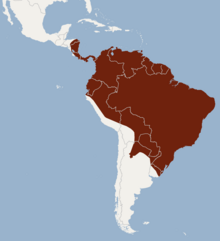Riparian myotis
| Riparian myotis | |
|---|---|
| Scientific classification | |
| Domain: | Eukaryota |
| Kingdom: | Animalia |
| Phylum: | Chordata |
| Class: | Mammalia |
| Order: | Chiroptera |
| Family: | Vespertilionidae |
| Genus: | Myotis |
| Species: | M. riparius
|
| Binomial name | |
| Myotis riparius Handley , 1960 | |

| |
The riparian myotis (Myotis riparius), is a
myotis.[2]
Taxonomy
The riparian myotis was originally described as a subspecies of velvety myotis in 1960. In 1973, it was raised to the species level.[2]
Description
The riparian myotis has long, woolly fur. The dorsal fur can vary geographically from a reddish to a blackish tinge.
Range and habitat
M. riparius is distributed widely throughout the neotropical region, and occurs from
rainforests, savannas, and open habitats throughout this region. It is most commonly seen from sea level to 2,000 meters above sea level. It has been seen in grasslands as well as agricultural fields.[2]
The riparian myotis tends to prefer primary forests and preserved habitats. They have been observed roosting under tree bark and caves. They have been observed co-roosting with black myotis, Silver-tipped myotis, and Velvety free-tailed bat. They can form colonies of up to 50 individuals.[2]
References
- . Retrieved 8 January 2023.
- ^ . Retrieved 27 October 2020.

